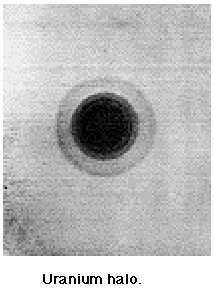 uranium family. It was
charcterized by a dark central disk surrounded by a set of rings with radii
corresponding to the alpha ranges of the daughter radioactivities in the uranium chain.
uranium family. It was
charcterized by a dark central disk surrounded by a set of rings with radii
corresponding to the alpha ranges of the daughter radioactivities in the uranium chain.
Derek York *
Department of Physics, University of Toronto
(from EOS, v. 60, no. 33, pp. 617-618, Aug. 14, 1979, publication of the American Geophysical Union)
[Illustrations from Henderson and Sparks, 1939]
Pleochroic halos had been known for about a quarter of a century before the geologist, J. Joly, explained that they owed their origin to the newly discovered phenomenon of radioactivity [Joly, 1907]. With the aid of a microscope, such halos are usually seen as small darkened circular spots surrounded by dark or colored rings. Joly proposed that the tiny mineral inclusions frequently seen at the centers of the halos were radioactive and that the passage of alpha particles from the inclusion through the host crystal produced the discoloration seen. Uranium was known to decay through a whole series of radioactive daughters, a number of which also ejected alpha particles. The energies of these in particles were characteristic of each emitter, and so each alpha-emitting radioactive element in the decay chain ejected he's with a characteristic range in a given medium. Thus, said Joly, the various rings in a halo corresponded to the ranges in the mineral of the or particles from particular members of the uranium decay chain. Herein was a beautiful, almost photographic, record of the radioactive process, as it had gone on for hundreds of millions of years. Joly's explanation was soon accepted, and during the next 30 or so years, a number of investigators, including Joly, examined halos in some detail [Holmes, 1931]. The hope that they might be useful for the measurement of the ages of rocks was a strong motivation. The idea was that laboratory-induced discoloration of minerals by known It doses could be compared with the natural discoloration in halos, thereby indicating the natural dose involved in the generation of the halos. This natural dose could then easily be converted into an age, if the uranium content of the radioactive inclusion at the center of the halo were known. The hopes of using pleochroic halos foundered, however, on the great difficulty of quantitatively measuring the degree of discoloration of a mineral. As a timepiece, the pleochroic halo was an even bigger disappointment than its contemporary, U-He dating. The classical era for the study of halos came to an end with the outbreak of the Second World War. It was also marked by the appearance in the Proceedings of the Royal Society of London of two striking papers [Henderson, 1939; Henderson and Sparks, 1939] by G. H. Henderson of Dalhousie University, Nova Scotia. These papers form the basis of the remainder of our discussion.
By 1939, Henderson had examined many micas from around the world and had
noted the occurrence of pleochroic halos in roughly half of these. In his paper
with Sparks, Henderson set out to classify the halos into distinct types.
Clearly, the commonest was that produced by the
 uranium family. It was
charcterized by a dark central disk surrounded by a set of rings with radii
corresponding to the alpha ranges of the daughter radioactivities in the uranium chain.
uranium family. It was
charcterized by a dark central disk surrounded by a set of rings with radii
corresponding to the alpha ranges of the daughter radioactivities in the uranium chain.
Significantly less common were somewhat similar roles which were a result
of the 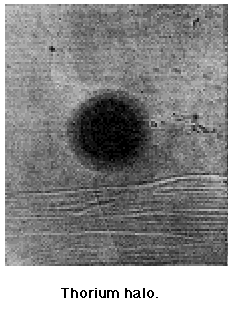 thorium chain.
Occasionally, a compound halo that was due to the combined effects of uranium
and thorium was found. In addition to these immediately understandable halos,
Henderson and Sparks recorded four other types of structure, which they called
A, B, C and D. These were particularly interesting because they had few rings,
but what rings there were had radii corresponding to the ranges of alpha
particles emitted by short-lived members of the 238U family.
thorium chain.
Occasionally, a compound halo that was due to the combined effects of uranium
and thorium was found. In addition to these immediately understandable halos,
Henderson and Sparks recorded four other types of structure, which they called
A, B, C and D. These were particularly interesting because they had few rings,
but what rings there were had radii corresponding to the ranges of alpha
particles emitted by short-lived members of the 238U family.
The 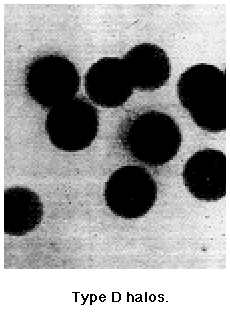 D type, for instance, appeared under the microscope merely as a simple
dark disk, whose radius corresponded, according to Henderson and Sparks [1939],
with the expected range in biotite of the alpha particles from radium [about 16
micrometers]. Most interesting of all, however, were types A, B, and C. Their
existence and interpretation are the reasons for this note.
D type, for instance, appeared under the microscope merely as a simple
dark disk, whose radius corresponded, according to Henderson and Sparks [1939],
with the expected range in biotite of the alpha particles from radium [about 16
micrometers]. Most interesting of all, however, were types A, B, and C. Their
existence and interpretation are the reasons for this note.
Types A, B, and C halos were all thought by Henderson and Sparks to have been produced solely by extremely short-lived isotopes of polonium. No ring owing to the longer-lived progenitors in the uranium chain was seen.
Type A was simplest. It was 'a dark disk with a sharp outer boundary.' The disk radius agreed within 3% with the range of alpha particles from 210Po, and the investigators settled for this isotope as the likely source of type A halos. They noted it might also have been because of either 228Th or 222Rn. However, the absence of rings owing to later activities seemed to rule these two possibilities out. In contrast, 210Po is the last alpha emitter in the 238U chain, and so if it were possible to isolate it in a biotite, it might produce a single A-type disk.
The 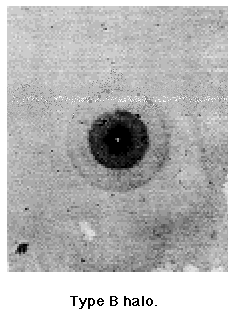 type B halo looked like a type A disk
with an outer ring added. The radius of the latter corresponded with its having
been produced by 214Po. Since the halflife of the latter is less than
200 microseconds, Henderson and Sparks suggested that the halo parent was
probably 214Pb or 214Bi.
type B halo looked like a type A disk
with an outer ring added. The radius of the latter corresponded with its having
been produced by 214Po. Since the halflife of the latter is less than
200 microseconds, Henderson and Sparks suggested that the halo parent was
probably 214Pb or 214Bi.
Finally, the
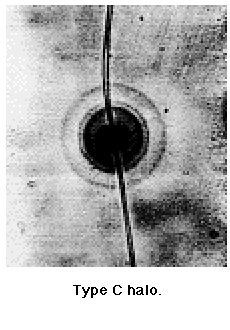 type C halo appeared to be similar to
a type B with an intermediate ring added. The radius of this new ring was only
about 4% higher than would be expected if it were due to alphas from
218Po. It was therefore concluded that the rings in type C halos were
produced by 218Po, 214Po and 210 Po.
type C halo appeared to be similar to
a type B with an intermediate ring added. The radius of this new ring was only
about 4% higher than would be expected if it were due to alphas from
218Po. It was therefore concluded that the rings in type C halos were
produced by 218Po, 214Po and 210 Po.
Here then was the origin of the concept of polonium halos. Now in suggesting that the types A, B, and C halo structure owed their origin to polonium isotopes, Henderson and Sparks realized that they were raising interesting questions, for 218Po, 210Po, 214Pb, and 214Bi have half-lives measured in days or minutes; 218Po, for instance, has a half-life of about 2 min. Therefore, in 1 hour any given number of 218 Po atoms will have decayed one-million-fold. In 2 hours, the initial number will have decayed by a factor of 10^12. Clearly then, if there is any measurable concentration of Po isotopes at a point in the earth, it can only have been produced there by decay of the much longer-lived earlier members of the uranium decay chain. If the Po isotopes are isolated from their parents, they will all have decayed away within a few hours. The situation Henderson had to face then was the following: Po halos must have been produced from a local concentration of Po in a mica. Since there are no uranium rings associated with Po halos, then the Po must have been separated from its supporting ancestors when it was being concentrated into the tiny volume which was to become the halo center. Since, as we have just seen, Po isotopes decay almost at the same moment as they are removed from their longer-lived ancestors, only a very limited number of separation and concentration processes may be envisaged. In fact, the second of Henderson's Royal Society papers was devoted to the elaboration of what seems to me to be the most probable explanation of these interesting halos.
In his discussion, Henderson [1939] emphasized one extremely important aspect about the mode of occurrence of Po halos. Henderson and Sparks [1939] observed that while many Po halos occur with their central nuclei randomly located within the cleavage planes of micas, many others are strung together along obvious channels or microconduits in the cleavage planes.
Here was the clue. Evidently, said Henderson, at some unknown time after crystallization, uranium-bearing hydrothermal solutions had been moving slowly through the rocks, penetrating and flowing through the tiny conduits. In these solutions, the uranium was supposed to be in equilibrium with its daughter products. That is, in particular, Po isotopes would also be present in solution. Suppose that at various points along such channels the chemical conditions were such that Po would precipitate from solution but alpha-emitting earlier members of the uranium chain would not. Then pointlike accumulations of Po would start to build up at these nuclei. The precipitated Po would almost immediately decay and halo formation would have begun. Meanwhile, more Po would precipitate from solution at these Po centers and a halo would eventually be produced. Henderson discussed the details of this process in terms of order of magnitude of flow rates and concentrations. To explain the Po halos of random occurrence, one merely had to postulate that the solutions permeated the micas along whole cleavage planes, not solely along channels.
If these halos are in fact produced by Po isotopes, then Henderson's theory, or some version of it, seems to me to be very probably correct. Henderson, however, might have taken another tack. He could have said: 'Given the extremely short Po half-lives involved, I see no reasonable way of isolating Po from U and concentrating it into embryonic halo nuclei. Therefore, I call into serious question all of our concepts of time and our understanding of the laws of radioactivity.' This, of course, would have meant a revolution in our understanding of physics perhaps more radical than that brought about by Einstein. Henderson, not surprisingly, did not propose such an absurd interpretation, based as it would have been on one isolated type of observation, when the accepted theories were based on a vast amount of information from a wealth of divergent fields.
Now Henderson's theory may not turn out to be correct. However, there is no doubt that he took the right philosophical step. From about 1950 onward, other radiometric dating procedures have been developed. For geology, the most important of these have been the K-Ar, Rb-Sr, and U-Pb methods. The widely differing radioactivities involved here are those of 40K, 67Rb, 238U, and 235U. These greatly differing systems, with distinct half-lives and varying responses to metamorphisms, have been brought to a remarkable state of development over the past 30 years. With them, it has proved possible to build up a coherent picture of the earth, the moon, and the meteorites as having been formed approximately 4.5 b. y. ago [York and Farquhar, 1972; Faure, 1977]. A consistent time scale for the evolution of the moon and the earth has been developed. We now know that continental rocks were forming on earth at least 3.8 b. y. ago in Greenland [Moorbath et al., 1972] and North America [Hurst et al., 1975; Barton, 1975]. We know that the biological evolution so well-documented by generations of paleontologists largely took place in the past 600 m. y. [York and Farquhar, 1972], although extremely primitive life probably existed on earth over 3 b. y. ago. We now understand that the continents have been drifting slowly, at a few centimeters per year, over the surface of the globe for at least the past 200 m. y. We have a precise time scale for the reversals of polarity of the earth's magnetic field [Cox, 1969]. Many more things have been established about the earth's history. And the time scale of it all has evolved in an internally consistent way principally from the study of these three radioactive systems. Within the past 15 years, the fossil-fission method of dating, based on the ever-so-slow spontaneous fission of 238U, has been added [Fleischer et al., 1964; Faure,1977] to the geochronologist's armory. Results from it are consistent with the three major techniques. When we turn to the dating of very recent events, the 14C, U disequilibrium, and thermoluminescence methods all fit in with our current conceptions of earth history. All of these results show that Henderson was correct in principle in accepting the current laws of radioactivity and looking for an explanation of the existence of Po halos within the context of what was then known of the time scale of earth history. Everything that has been discovered since, from the study of radioactivity in rocks, has served to justify Henderson's strategy. Because of its transparently obvious usefulness, geochronology based on radioactivity has now become a key part of general earth science. It is being practiced and developed in many countries by hundreds of scientists [York and Farquhar, 1972; Faure, 1977].
In light of the developments sketched above, it is truly extraordinary then that in the past dozen or so years an American scientist, R. V. Gentry, has chosen to do exactly what Henderson so wisely avoided. That is, Gentry has been trying to promote the idea that the existence in minerals of Po halos means that our presently accepted chronology of the earth's evolution may be grotesquely in error, by many orders of magnitude [Gentry, 1974]. Gentry's own observations and measurements of halos, i.e., his recording of high 206Pb/207Pb ratios and low U concentrations in Po halo nuclei [Gentry,1971], add support to Henderson's suggestion [Henderson, 1939] that types A, B, and C really are Po halos. They do nothing to detract from Henderson's theory of their mode of origin. Why, then, Gentry takes the position he does, totally ignoring the enormous mass of self-consistent geochronological data and theory, is difficult to understand. He presents no alternative theory and does not even consider why geochronology as presently practiced is so successful. Ironically, in a relatively recent paper [Gentry et al., 1976], Gentry accepts Henderson's theory of formation of Po halos observed in coalified wood. This surprising acceptance was justified by Gentry and his coauthors with the statement that it is easy to accept the idea of uranium-bearing (and therefore Po-bearing) solutions permeating this type of matrix. However, they still recoiled from accepting Henderson's mechanism as operating in micas, noting the extreme slowness of diffusion in the solid state. But this, of course, is irrelevant, as Henderson was perfectly well aware of the slowness of solid state diffusion. This was why, as we have explained above, Henderson took great pains to show that the U-bearing solutions would permeate the micas along small channels or susceptible cleavage planes.
Throughout the preceding discussion, I have tentatively accepted Henderson's suggestion that the types A, B, and C halos are Po halos. The fact that this acceptance is not complete is based on another consideration, which is important in the present context. This is that only a handful of scientists are currently studying pleochroic halos. Their study has been left by the wayside as the other radiometric dating methods have been driven far forward. * Because there is no large pool of modern measurements (with modern techniques) on halos available in the recent literature, and because there are not hundreds of scientists poring over halos and disputing each other's contentions in such a way as to bring full understanding to all the various halo phenomena, it would be foolish to draw earth-shattering conclusions from their characteristics. Henderson himself was puzzled by some discrepancies in ring radii measurements, and others [Moazed et al., 1973] have recently suggested that in fact the so-called Po halos are merely 'variants of standard U-halos.' Furthermore, we know little of the relative sensitivities of halo rings to various metamorphic conditions.
Finally, l note that in a recent EOS, R. G. Kazmann of Louisiana State University, in summarizing the proceedings of a conference at that university (attended by the author) on 'time,' adopted Gentry's viewpoint and was skeptical of the reliability of the methods and interpretations of modern geochronology [Kazmann, 1979]. He worried about the weight which should be given to geochronological advice in engineering planning. He was particularly anxious about it in connection with the evaluation of the stability of sites selected for nuclear waste disposal. I trust that what I have written has shown that Kazmann's fears are completely groundless. If the only hazards connected with nuclear waste disposal were due to the questions raised by Gentry about the fundamentals of geochronology, then constructing disposal sites would be the safest occupation known to man. To worry about waste disposal, on these ground[s], is to bury one's head ostrichlike in the sands of geological time.
*
In August 1978 at
Snowmass, Colorado, the U.S. Geological Survey and several other American
organizations sponsored the Fourth International Conference, Geochronology,
Cosmochronology, Isotope Geology. Two-hundred twenty-eight papers were
presented by scientists from 30 countries. Hundreds of research workers
attended, including representatives of the Soviet Union and the People's
Republic of China. At what was by far the most successful meeting yet held
of the worlds geochronologists, not a single paper was presented on
pleochroic halos!
Barton, J. M., Jr., Rb-Sr isotopic characteristics and chemistry of the 3.6 b.y. Hebron gneiss, Labrador, Earth Planet. Sci. Lett., 27, 427-435, 1975.
Cox, A., Geomagnetic reversals, Science, 163, 237-245, 1969.
Faure, G., Principles of Isotope Geology, 464 pp., John Wiley, New York, 1977.
Fleischer, R. L., P. B. Price, and R. M. Walker, Fission-track ages of zircons, J. Geophys. Res., 69, 4885-4888,1964.
Gentry, R. V., Radiohalos: Some unique lead isotope ratios and unknown alpha radioactivity, Science, 173, 727-731,1971.
Gentry, R. V., Radiohalos in radiochronological and cosmological perspective, Science, 134, 62-66,1974.
Gentry, R. V., W. H. Christie, D. H. Smith, J. F. Emery, S. A. Reynolds, R. Walker, S. S. Cristy, and P. A. Gentry, Radiohalos in coalified wood: New evidence relating to the time of uranium introduction and coalification, Science, 194, 315-318, 1976.
Henderson, G. H., A quantitative study of pleochroic halos, V, The genesis of halos, Proc. Roy. Soc. , A, 173, 250-264, 1939.
Henderson, G. H., and F. W. Sparks, A quantitative study of pleochroic halos, IV, New types of halos, Proc. Roy. Soc., A, 173, 238-249, 1939.
Holmes, A., The age of the earth, Bull. Nat. Res. Counc. (U.S.), 80, 159-196,1931.
Hurst, R. W., D. Bridgewater, K. D. Collerson, and G. W. Wetherill, 3600 m.y. ages from very early Archaean gneisses from Saglek Bay, Labrador, Earth Planet Sci. Lett., 27, 393-403, 1975.
Joly, J., Pleochroic halos, Phil. Mag., 13, 381 -383, 1907.
Kazmann, R. G., Time: in full measure, EOS Trans. AGU, 60, 21 -22, 1979.
Moazed, C., R. M. Spector, and R. F. Ward, Polonium radiohalos: An alternate explanation, Science, 180, 1272-1274, 1973.
Moorbath, S., R. K. O'Nions, R. J. Pankhurst, N. H. Gale, and V. R. McGregor, Further Rb-Sr age determinations on the very early Precambrian rocks of the Godthaab district, West Greenland, Nature, 240, 78-82, 1972.
York, D., and R. M. Farquhar, The Earth's Age and Geochronology, 178 pp., Pergamon, New York,1972.
Derek York was born in 1936 in Yorkshire, England. He attended Oxford University from 1954-1960, during which time he completed his B.A. and Ph.D. degrees. Since 1960, he has been on the staff of the University of Toronto, Canada, where he is currently a full professor of physics. His research career has been largely devoted to solving problems connected with the accurate estimation of the time scale of the earth's evolution. In the past decade, he has concentrated on the development of the 40Ar/39Ar method of dating. His current projects include the extension of the 40Ar/39Ar method so that it overlaps with 14C dating, the development of a thermochronometer to link 40Ar/39Ar dating with paleomagnetism for Precambrian apparent polar wander studies, and the use of a laser as a microprobe dating device. In addition to numerous papers on geochronology, York has published two books: The Earth's Age and Geochronology (with R. M. Farquhar), and Planet Earth. The latter has been translated into Japanese and Italian.